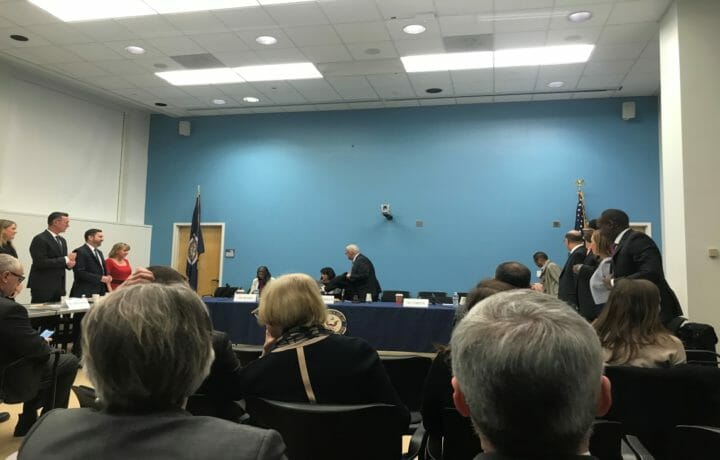Today, Congressman Gerry Connolly (D-VA), Chairman of the Subcommittee on Government Operations, hosted a roundtable discussion on the challenges private sector companies face when seeking federal security clearances for prospective and current employees. Industry leaders discussed the previous background investigation and adjudication backlog and made proposals to reform and improve the security clearance process.
The FY 2020 NDAA required the Department of Defense to streamline and monitor the security clearance process, and improve on reporting clearance metrics due to an amendment requiring stakeholders to report on their backlog of personnel security clearance adjudications.
Even though the DoD failed on all target timelines for adjudications in 2019, industry partners are pleased with DCSA closing in on their goal of a 200,000 investigations inventory. The Cross-Agency Priority (CAP) Goal for Security Clearance, Suitability, and Credentialing Reform hopes to continue this work through four streams: Trusted Workforce 2.0, modernizing the clearance process, securing mission capable information technology, and continuous performance improvement.
ISSUES BROUGHT UP BY Industry
- It is a challenge for contractors, especially small, to have a talent pool of cleared personnel to tap into. Security clearance timelines can also be a deterrent of qualified, hardworking talent when they can obtain employment quickly in the commercial sector.
- Clearance timelines cause billet openings on contracts, lowering revenue streams for businesses, ultimately affecting customer missions not being fulfilled.
- Jennie Brackens of SAIC spoke to being required to attach individuals to a contract per a DD254, which prevents contractors from creating a bench of talent, creating a catch-22 in the hiring process.
- Some positions may be misplaced or programs may not necessarily need to be cleared. Some contracts may need to be listed as unclassified due to the work. On the flip side, there are some obstacles in the security clearance process that should be removed altogether.
- Reciprocity between adjudicating agencies is still a hurdle in getting cleared individuals in the door. Greg Torres of Booz Allen notes, “Government writing policy is a huge compromise. You can’t get everyone in the IC to agree, so everyone is doing each process differently, and that’s when you run into issues like reciprocity of security clearances not working.”
Things the Government has done well
- Industry partners present at the meeting were ecstatic about the way information has been shared between government and industry as of recent. Joseph Kraus of ManTech says, “we are in concert with the government and look forward to being a part of the process.”
- The TS and TS/SCI adjudicative guidelines were identical, but the number of individuals cleared at the SCI level has improved from 30% to 80%. This has created a better pool of talent for contractor recruitment.
Recommendations to the Government
- More than worrying about the backlog running total, government should be thinking more about the speed of the security clearance process.
- Improvement on data metrics: instead of reporting on the 90% fastest clearance investigations, they should be covering and sharing with the public the rest of the data.
- Government should be inviting industry to public hearings on a quarterly basis to discuss those metrics.
- Different personnel security systems should be accessible by Facility Security Officers. FSO’s that are unable to look at a candidates profile in Scattered Castles as opposed to JPAS (Joint Personnel Adjudication System) increases the time to hire due to not seeing negative notes. Giving security personnel higher visibility will ultimately improve on fulfilling customer mission and reciprocity.
Other things to ponder
- Technology modernization and cybersecurity will be especially important for Trusted Workforce 2.0.
- Many individuals on the panel have a 360-degree view of this process, working for government and industry, for small and large contractors. A few of them noted that as government personnel writing these policies, they did not see the security clearance hurdles. As contractors, they are feeling the brunt of it and the problem is clear.
- Charlie Sowell at iWorks has decided to get innovative in the way they do things. He explains how they submit candidates for Secret level clearances, getting them cleared faster. Following this step, they submit candidates for TS level clearances, usually getting an interim in 60 days. “Small businesses find loopholes, but it shouldn’t be that way.”
- Continuous Evaluation or continuous vetting has helped in lowering the clearance backlog. However, what might we lose from not knocking on a neighbor’s door every five years?
All in all, industry believes that the government has instilled a sense of shared responsibility by enabling a trusted workforce through consistent reporting requirements, awareness, and strengthened partnerships with other mission areas and industry
The roundtable participants included Paul Engola of Leidos, Joe Kraus of Mantech, David Berteau of the Professional Services Council (PSC), Lee Rizzo and Jennie Brackens of SAIC, Greg Torres of Booz Allen Hamilton, Heather Sims of General Dynamics, Charlie Sowell of iWorks, Kevin Manuel-Scott, RONIN IT Service, and Elsa Lee of Advantage SCI.
“Private sector companies play a vital role in protecting national security and helping the federal government achieve critical agency missions,” said Chairman Connolly. “This public-private partnership is critical to our national security. Our roundtable is an opportunity to hear from the stakeholders most directly affected by the system’s shortcomings, and is an important step toward a more effective, timely, and transparent security clearance process.”




